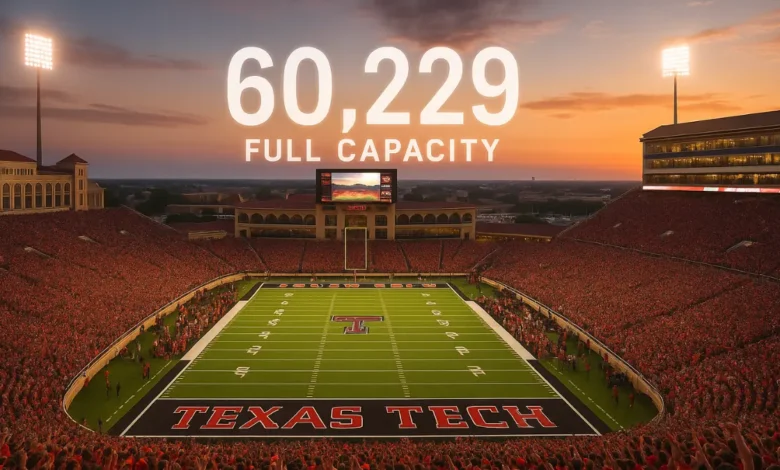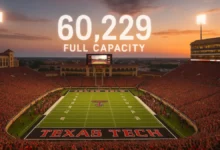Texas Tech Stadium Seating Capacity: The Complete Story

Discover the full story behind Texas Tech Stadium’s seating capacity — from its 1947 origins to its modern 60,229-seat legacy — and how each expansion shaped Red Raider football history.
Introduction to Texas Tech Stadium
When people talk about college football in Texas, they often picture a roaring crowd, the smell of tailgate smoke, and the echo of school chants reverberating through a grand stadium. For Texas Tech University, that stadium is Jones AT&T Stadium, affectionately known to fans as “The Jones.”
It’s more than just a football field — it’s a living symbol of pride, community, and competitive spirit. The Texas Tech stadium seating capacity isn’t just a number; it represents the scale of fan loyalty, the passion for the game, and the evolution of the university’s athletic vision. Over the years, this capacity has grown dramatically, reflecting the rise of Texas Tech as a major force in college football.
Today, the stadium stands as a benchmark of how architecture, engineering, and school pride come together. Understanding its seating capacity means looking into its history, expansions, and what each renovation brought to fans and athletes alike.
The Early Years: Modest Beginnings and First Expansions
The Opening Era
Jones AT&T Stadium opened in 1947 under a different name — simply as Texas Tech Stadium. Its original seating capacity was approximately 27,000 spectators. Back then, this was more than enough to host local fans and students, as Texas Tech’s football program was still gaining national recognition.
The design of the early structure was simple: a straightforward bowl with open bleachers and limited amenities. Yet, it carried an air of optimism. The architecture was intentionally designed for future growth, anticipating that Red Raider football would one day command far larger audiences.
First Expansions in the 1950s and 1970s
By the late 1950s, the university saw attendance rising, and the first major expansion came in 1959. Engineers physically moved the west stands outward — an innovative method at the time — to increase capacity. The result was an increase from around 27,000 to over 41,000.
Then came another expansion in the early 1970s, which added thousands of seats to the north and south ends of the stadium. This brought the Texas Tech stadium seating capacity closer to 48,000. The growth mirrored Texas Tech’s rising prominence in the Southwest Conference, as more students and alumni filled the stands for every game.
The Modern Expansion Era: From 2000s to 2010s
The 2003 Transformation
The early 2000s marked a new chapter in the stadium’s evolution. In 2003, Texas Tech completed a massive west side renovation that included luxury suites, club seats, and expanded press facilities. This wasn’t just about adding seats — it was about enhancing the fan experience.
With the new suites came comfort, better views, and a modern architectural flair that gave “The Jones” a more premium, big-league look. The project added roughly 2,000 more seats, pushing capacity toward the 55,000 mark.
The East Side and North End Zone Upgrades
Between 2008 and 2010, the east side of the stadium underwent an even more dramatic renovation. Inspired by Spanish Renaissance architecture, the addition brought new suites, club areas, and modern seating designs. These enhancements further increased the total capacity to 60,454.
By 2010, the stadium was recognized as one of the largest on-campus college football venues in Texas. The introduction of new video boards, upgraded lighting, and improved sound systems elevated the energy of every home game.
The 2013 Enhancements
In 2013, the university added a new north end zone colonnade, upgraded video boards, a better sound system, and improved concourse connections. Around 368 new seats were added, but more importantly, the renovations unified the stadium’s design. Fans could now circulate around the entire bowl with ease, creating a more connected and immersive game day experience.
Recent Developments: The South End Zone Project
The Push Toward Modernization
By the early 2020s, Texas Tech’s leadership recognized that staying competitive in college athletics required even more modernization. Thus began the South End Zone Project, one of the most ambitious construction efforts in the university’s athletic history.
This project introduced new locker rooms, a state-of-the-art training center, and multiple levels of premium seating, including loge boxes, suites, and field-level clubs. It reimagined how fans, players, and media interacted within the stadium.
Temporary Capacity Reductions
During construction, several thousand seats were removed, temporarily reducing the Texas Tech stadium seating capacity to approximately 56,200 during the 2023 season. These temporary changes primarily affected the student section and band seating, but the university made strategic relocations to minimize disruption.
When construction concluded, the new and improved stadium reclaimed and optimized its seating configuration, resulting in an official capacity of 60,229 — the current figure used today.
The Current Capacity Explained
What 60,229 Represents
The number 60,229 isn’t just a statistic — it represents years of thoughtful expansion, renovation, and modernization. This figure is the official capacity of Jones AT&T Stadium as of its latest redevelopment.
However, real-world attendance can fluctuate. During high-demand games, the stadium has been known to exceed that number. Standing-room areas, press spaces, and temporary seating allow for flexibility. The record attendance stands at 61,836, set during a historic Texas Tech vs. Oklahoma State matchup.
Comparative Context
Within the state of Texas, Jones AT&T Stadium ranks among the top seven largest football stadiums. It may not rival the gigantic capacities of Texas A&M’s Kyle Field or the University of Texas’ Darrell K Royal Stadium, but it holds its own as a powerhouse venue with one of the most passionate fan bases in the country.
Nationally, a 60,000+ seat stadium positions Texas Tech among the upper tier of college football programs, especially considering that some universities use off-campus or shared facilities to reach similar numbers. Texas Tech’s stadium is 100% on-campus — an important distinction that deepens its connection with students and alumni.
Seating Distribution and Structure
Student and Band Sections
Student involvement is the lifeblood of any college football environment. Historically, Texas Tech has dedicated more than 13,000 seats to students across 14 sections. These seats ensure that the loudest and most energetic fans are strategically placed near the field.
The Goin’ Band from Raiderland — one of the oldest collegiate bands in the nation — also occupies a prime location to energize the crowd. Recent changes relocated the band from the south end zone to the east side, allowing better acoustics and visibility.
Premium Seating and Luxury Areas
The stadium’s premium offerings include luxury suites, club seats, loge boxes, and field-level lounges. These sections cater to alumni, donors, and corporate partners seeking a high-end game day experience.
The west side tower is home to several levels of luxury seating, while the new south end zone facilities feature exclusive areas with private bars, catering, and lounge access. These spaces are part of Texas Tech’s strategy to enhance fan comfort while generating sustainable revenue for athletics.
Accessibility and Fan Comfort
Texas Tech has prioritized accessibility, ensuring compliance with ADA standards and focusing on ease of movement. The widened concourses, modern restrooms, and digital ticketing systems are all part of this effort. Fans enjoy not just more seats, but a better experience per seat — an essential component of maintaining a strong reputation among college football venues.
Challenges and Strategic Decisions in Expanding Capacity
Balancing Growth and Aesthetics
One of the biggest challenges in expanding Texas Tech stadium seating capacity has been maintaining architectural harmony. The Spanish Renaissance design of the stadium must stay consistent, even as new tiers and additions are built.
Engineers must consider load distribution, sight lines, and the overall aesthetic of the stadium. A single poorly designed section could compromise the symmetry of the entire structure.
Revenue vs. Inclusivity
Expanding capacity often involves tradeoffs. More premium seating means fewer general seats, but higher overall revenue. Texas Tech’s administration has been careful to maintain balance — ensuring that students, alumni, and families still have affordable options while introducing modern, revenue-generating areas.
The university’s recent restructuring demonstrates that inclusivity and profitability can coexist if carefully planned.
Safety and Infrastructure
Every seat added affects the flow of fans entering and exiting the stadium. For this reason, renovations always include new exits, restrooms, and expanded concourses to prevent overcrowding. Texas Tech’s safety-first approach ensures that even when the stadium is at full capacity, fans can move freely and securely.
The Game Day Experience at Full Capacity
Atmosphere and Acoustics
Few things match the thrill of a sold-out crowd at Jones AT&T Stadium. When more than 60,000 fans fill the seats, the noise level is electric — a roaring wave that energizes players and intimidates visiting teams.
The stadium’s design amplifies sound, particularly with the newer south end zone enclosure that traps and reflects crowd energy back onto the field. It’s part of why Texas Tech is known for having one of the most intense home-field advantages in college football.
Visibility and Comfort
Every expansion has been done with sight lines in mind. Fans in upper levels still enjoy clear, direct views of the field, with no major obstructions. The large high-definition video boards add to the visual experience, ensuring that no play goes unseen.
Comfort improvements like cushioned seating, more legroom, and shaded areas have also enhanced the overall experience — turning game days into memorable events for all ages.
Future Prospects for Texas Tech Stadium Seating Capacity
Potential for Further Growth
While the current seating capacity of 60,229 is impressive, there remains potential for future growth. Structural studies suggest that the stadium could, in theory, be expanded slightly beyond 65,000 seats if demand justifies it.
However, future projects are likely to focus more on technology, fan amenities, and digital experiences rather than sheer numbers. Smart seating systems, augmented reality displays, and in-seat ordering could redefine what “capacity” means in the modern era.
Maintaining Legacy and Innovation
Texas Tech’s challenge is maintaining the balance between legacy and innovation. The stadium’s heritage, architectural charm, and fan culture are non-negotiable. Any future upgrades must respect that history while embracing technological progress.
With continued investment, the stadium will remain a centerpiece of campus life and a beacon of Red Raider pride for generations to come.
Frequently Asked Questions (FAQs)
Q1: What is the current seating capacity of Texas Tech Stadium?
The official seating capacity is 60,229 as of the most recent renovations.
Q2: What was the original capacity when it first opened?
When the stadium opened in 1947, it could seat approximately 27,000 fans.
Q3: Has the capacity ever gone higher than 60,229?
Yes. The record attendance reached 61,836, achieved during a high-profile game against Oklahoma State.
Q4: Why was the capacity temporarily reduced in 2023?
Due to construction of the new south end zone facility, about 3,900 seats were removed temporarily to make way for upgrades.
Q5: Will Texas Tech expand seating capacity again?
Possibly. While there are no official plans for major expansion soon, the stadium’s design allows for future growth if demand increases.
Q6: How does Texas Tech’s stadium compare to others in Texas?
It ranks among the top seven largest football stadiums in Texas and one of the most iconic on-campus venues in the state.
Q7: What makes the stadium experience unique?
Its passionate fan base, architectural beauty, and acoustic design create a game-day atmosphere unlike any other in college football.
Conclusion
The story of Texas Tech stadium seating capacity is not just about construction numbers — it’s a chronicle of growth, pride, and progress. From its humble beginnings with 27,000 seats to its current 60,229-seat masterpiece, the stadium mirrors the rise of Texas Tech University itself.
Every expansion, every renovation, and every roar from the crowd has added a new layer to its history. As technology evolves and the program continues to flourish, Jones AT&T Stadium will remain one of the most exciting and respected venues in college football — where every seat tells a story of loyalty, legacy, and Red Raider passion.

